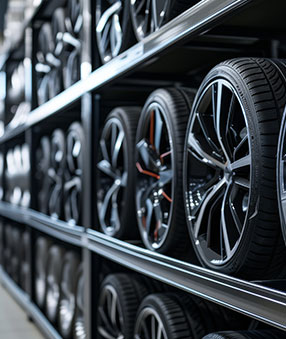
We rarely spend time thinking about our tires until something goes wrong. The engine, transmission, and other big components usually demand our attention. They're bigger, more expensive, and seem to cause more problems when they go wrong.
That doesn't mean we should ignore our tires, though! As the only part of our vehicle in contact with the road, tires might be one of the most essential parts of our ride. That's why it's crucial to always be aware of our tire health. Here are a few signs to look out for when evaluating the health of your tires.
Low Pressure
Low pressure isn't always a sign your tires are wearing out. Not every tire is airtight and some loss over time is expected. On the other hand, if your tires are consistently low, even after refilling, you may want to check for issues. Some things, like a nail or other items are easy to spot. If you're lucky, these can even be patched or plugged, prolonging the life of your tire.
If you can't find a foreign object and your tire is still losing pressure, take your vehicle to a professional and have them look at your vehicle.
Low Tread
Most tires are rated to last between 30,000 and 60,000 miles and recommended to be replaced every 5-6 years. As the only part of your car connecting you to the road, your tires will see a lot of use during that time. Having your tires rotated regularly will provide many opportunities for you and mechanics to check the tread for wear and tear. Even away from a mechanic, you can always use a penny to check for wear. Simply put the penny in a tread groove with Lincoln's head facing you, upside down. If all of Lincoln's head is visible, it might be time to get your tires checked.
Cracks
Cracks are caused when your tires are damaged, exposed to harsh weather/climates, or simply just by aging. Regardless of how the cracks occurred, they can be dangerous and may need to be looked at by a professional. Hitting a rock, curb, or other hard object with enough force can crack the rubber, compromising the integrity of your tire. If this occurs, your tire might be unsafe to drive on.
Bubbles and Bulges
Bumps and bulges in your tread wall generally require immediate attention. This is a potentially dangerous situation that could result in a blowout if not addressed quickly. Bubbles indicate a major problem with the strength and structure of your tire and should not be ignored. If you notice any odd bumps, bubbles, or bulges on your tires, bring your vehicle in to Tire Rack to have your tires checked out by a mechanic.
Damaged Rubber
While some things may or may not be indicators that it's time to get new tires, damaged or missing rubber is definitely a sign. This type of damage rarely happens naturally and is usually the result of hitting something hard or sharp. If parts of your tire are missing or you can see deep gashes/tears, your tires aren't safe to drive on and you should bring them in to a mechanic as soon as you're able.
Old Age
Tires aren't immune to aging, even if it's a car that's rarely driven and sits in your garage. Think about that old basketball or garden hose that's been untouched for years. The rubber degrades even if it hasn't been used. The same thing will happen to your tires over time. However, only consider replacing these tires if a sudden change in use occurs. If that beater has sat for years and you don't plan on driving it anytime soon, you probably won't be needing any new tires.
Tire Rack Has All Your Tire Needs
Ready for your next big adventure? Need a new set of tires? Or maybe you just need to have that flat patched and filled. Tire Rack offers rotations, check-ups, alignments and more. Shop from top brands like Bridgestone, BF Goodrich, Continental, and Firestone. Whatever your tire and wheel needs are, visit Tire Rack is the place to go. Even better, you can find your perfect set of tires from the comfort of your own home. Discover how you can shop for tires with the Progressive Leasing App by visiting our Tire Rank page right here.









